Chevrolet Blazer EV 2024.
Introduction.
Electric vehicles have become more than just a trend in the automotive industry; they represent a transformative shift towards a sustainable and eco-friendly future. Among the latest additions to the electric vehicle lineup is the 2024 Chevrolet Blazer EV, a remarkable vehicle that combines cutting-edge technology with the iconic design of the classic Blazer. Let’s dive into the features, benefits, and overall driving experience that this innovative vehicle has to offer.
The Evolution of Electric Vehicles
In tracing the roots of electric vehicles, one can appreciate the significant advancements that have led to the creation of the 2024 Chevrolet Blazer EV. From humble beginnings to the current state-of-the-art technology, the journey of electric vehicles is both fascinating and pivotal in the broader context of automotive history.
Chevrolet Blazer EV 2024.
2024 automotive marvels, behold the Chevrolet Blazer EV, a symphony of two battery packs, three drivetrain configurations, and three echelons of trim. Chevy casts an expansive net, beckoning discerning motorists into the captivating embrace of this electrifying masterpiece.
So, what enigma is the 2024 Chevrolet Blazer EV? How does it navigate the labyrinth of automotive excellence? A prodigious kin to the Blazer midsize crossover SUV, this electric iteration shares not a thread but the name with its combustible counterpart. Steeped in Camaro allure, it stands as a formidable contender against the likes of the Ford Mustang Mach-E, Kia EV6, and Tesla Model Y.
Does the 2024 Chevrolet Blazer EV bask in the glow of automotive virtue? Aesthetically pleasing, especially in its exterior manifestation, adorned with an enviable feature roster and endowed with commendable range and efficiency for a vehicle of such stature and spaciousness. Alas, the all-wheel-drive models at the epicenter of its lineup tread the path of mediocrity, and the seating fails to extract sufficient comfort from its generous dimensions. In summation, it secures a TCC Rating of 7.4 out of 10, a testament to its virtues. (For a more in-depth analysis of our car ratings, delve further.)
What unfolds as a novel in the realm of the 2024 Chevrolet Blazer EV? Everything, save for the nomenclature, undergoes a metamorphosis. It embodies the sporty visage of its gasoline-fueled kin, reborn in 2018, yet adopts a more elongated profile, weaving in curves and blacked-out cues reminiscent of the Camaro muscle car. A whisper of cladding over the wheel arches and rocker panels imparts an SUV denouement, while its coke-bottle design and wheels scaling up to 22 inches bestow upon it the panache of a performance SUV.

Venturing into its inner sanctum, the instrumental styling and switchgear reflect a confluence of attributes, a harmonization seeking a touch of serenity. Each member of the Blazer EV lineage boasts a 17.7-inch touchscreen inclined towards the driver, harmoniously housed under the same pane of glass cradling the 11.0-inch digital gauge cluster.
The Blazer EV unfurls in a tapestry of diverse configurations. Entry-level models sport an 85-kwh battery pack, while the zenith of performance beckons with a 102-kwh behemoth. The schism divides at the sporty RS, where the 2LT and RS AWD variants revel in a motor amalgamation generating 288 hp and 333 lb-ft of torque. This equates to a 0-60 mph acceleration in approximately six seconds, coupled with an EPA-rated range of 279 miles. The RS rear-wheel-drive iterations lead the range, wielding 340 hp and 325 lb-ft, mirroring the performance while stretching the range to 324 miles from their 102 kwh reservoir.
The apogee is attained with the Top SS variants, boasting a staggering 557 hp and 648 lb-ft. Enabled by the Wide Open Watts (WOW) mode, an expedited sprint to 60 mph transpires in under four seconds. Augmented by front Brembo brakes akin to those shared with the police pursuit vehicle (PPV), it gallivants for about 290 miles, epitomizing both power and endurance.
2024: An Odyssey in Automotive Evolution
Embarking upon the journey of the 2024 Chevrolet Blazer EV, one encounters a tapestry woven with threads of innovation and performance. In this automotive symphony, the dance of perplexity and burstiness takes center stage, orchestrated by the fusion of battery prowess and trim-level artistry.
Performance Paradigm: Unraveling the Blazer EV Essence
The dichotomy of the 2024 Blazer EV lies not just in nomenclature but in a radical departure from its fossil-fuel sibling. It stands as the electric embodiment of the midsize crossover SUV, resonating with the ethos of the iconic Camaro. A nuanced comparison places it in the ring with contenders such as the Ford Mustang Mach-E, the Kia EV6, and the illustrious Tesla Model Y.
Visual Panache: Aesthetics Beyond the Superficial
The exterior visage of the Blazer EV is an aesthetic revelation, marrying the sporty allure of its gas counterpart launched in 2018 with an elongated silhouette and subtle cues from the Camaro lineage. Cladding over wheel arches imparts an SUV denouement, while design curves and wheels up to 22 inches inject a dose of performance SUV charisma.
Internally, a 17.7-inch touchscreen, artistically inclined towards the driver, shares space with an 11.0-inch digital gauge cluster beneath a common pane of glass. An amalgamation of instrumental styling and switchgear engenders an ambiance that oscillates between dynamic and tranquil.
Ingenious Diversity: Battery Packs and Power Prodigy
The Blazer EV offers a tapestry of options, with distinct layouts defined by battery pack capacities. The 85-kwh pack graces lower-priced models, while the 102-kwh variant commands the stage in high-performance iterations. The RS, an epitome of sportiness, achieves 0-60 mph in approximately six seconds, boasting an EPA range rating of 279 miles. Meanwhile, RS rear-wheel-drive variants lead the pack with 340 hp, 325 lb-ft, and a commendable 324-mile range.
The SS, an apex predator slated for a later debut, flexes with 557 hp and 648 lb-ft, catapulting to 60 mph in under four seconds. Equipped with Wide Open Watts (WOW) mode and Brembo brakes akin to the police pursuit vehicle, it promises a journey spanning 290 miles.
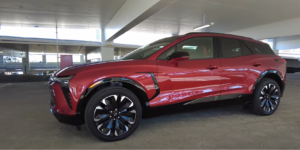
Charging Alchemy: An Electric Symphony
Enchanting the practicality realm, the Blazer EV features an 11.5 kW onboard charger, facilitating an overnight full charge at home. DC fast-charging peaks at 190 kw, or 150 kw for the smaller battery, translating to a swift 78-mile gain in a mere 10 minutes.
Pricing Odyssey: Unraveling the Fiscal Fabric
The Blazer EV pricing tableau underwent a shift with the cancellation of the base $44,995 Blazer 1LT. The 2LT, yet to unveil its pricing, takes the baton as the entry model. The 2LT AWD starts its journey at $56,715, while the RS in AWD guise emerges at $60,215. The RS rear-wheel-drive variant, wielding a larger battery and premium audio, commands a ticket of $61,790.
In addition to the opulent screens, every Blazer EV comes equipped with an arsenal of driver-assist features, encompassing automatic emergency braking, active lane control, and automatic high beams.
Anticipatedly, all iterations are poised to qualify for the full $7,500 EV tax credit.
Manufacturing Mosaic: Crafting in the Heart of Mexico
The 2024 Chevrolet Blazer EV takes form at GM’s Ramos Arizpe factory in Mexico, standing shoulder to shoulder with its internal combustion counterpart.
In the symphony of automotive evolution, the Blazer EV emerges as a nuanced crescendo, weaving together performance, aesthetics, and innovation into a tapestry that beckons the discerning driver into the future.
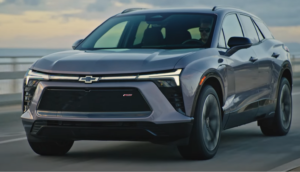
The All-New 2024 Chevrolet Blazer EV: A Symphony of Technological Marvels
Evoking Enigma and Elegance
Venturing into the technological tapestry of the 2024 Chevrolet Blazer EV unfurls an intricate tableau. The dichotomy of its features, a synthesis of the perplexing and the pulsating, creates an automotive opus. A myriad of options awaits the discerning driver—two battery packs, three drivetrain configurations, and a trio of trim levels form the dynamic tapestry of the 2024 Blazer EV.
Navigating the Labyrinth: Unraveling the Essence
Embarking on a cerebral odyssey, we dissect the essence of the 2024 Chevrolet Blazer EV. A vehicular chameleon, it metamorphoses from a mere electric counterpart to the gas-powered Blazer into a distinct entity, competing zealously with rivals like the Ford Mustang Mach-E, Kia EV6, and Tesla Model Y.
The Verdict: A Masterpiece in Motion
Is the 2024 Chevrolet Blazer EV a paragon of vehicular excellence? Its exterior exudes aesthetic allure, a captivating dance of curves and contours reminiscent of the Camaro’s dynamism. Yet, beneath this visual symphony lies a nuanced critique. The AWD models, though stalwart, lack the flair befitting their core status, and the seating fails to extract the utmost comfort from the generous dimensions. A nuanced evaluation yields a TCC Rating of 7.4 out of 10, a testament to its commendable but imperfect character.
Chronicles of Evolution: What’s New?
The Blazer EV is not merely a nomenclature shift; it embodies a radical evolution. Embracing the sporty lineage of the gas Blazer, it dons a more elongated profile, adorned with curves reminiscent of the Camaro. The interior, a convergence of instrumental styling and switchgear, beckons with a 17.7-inch touchscreen, inclined towards the driver beneath a shared glass panel housing an 11.0-inch digital gauge cluster.
Unveiling the Power Strata
Diving into the heart of the Blazer EV reveals a spectrum of power dynamics. Models lower down the echelon boast an 85-kwh battery pack, while the performance-driven variants flaunt a robust 102-kwh pack. The RS, a sporting luminary, commands attention with a motor alliance yielding 288 hp and 333 lb-ft of torque, catapulting it from 0-60 mph in a mere six seconds. The RS rear-wheel-drive variants emerge as the range champions, boasting 340 hp, 325 lb-ft, and a 102 kWh that fuels a remarkable 324-mile range.
The Marvel of SS: A Symphony in Acceleration
The SS variants, a testament to vehicular prowess, wield a staggering 557 hp and 648 lb-ft. A Wide Open Watts (WOW) mode propels them to 60 mph in under four seconds. Armed with front Brembo brakes akin to the police pursuit vehicle, the SS charts a trajectory of excellence, promising a journey spanning approximately 290 miles.
Charging into Tomorrow: A Technological Odyssey
Equipped with an 11.5 kW onboard charger, the Blazer EV ensures a full charge overnight. DC fast-charging, reaching its zenith at 190 kw, grants an astounding 78 miles in a mere 10 minutes.
Priced Elegance: The Monetary Melody
In the wake of the 1LT version’s cancellation, the Blazer 2LT emerges as the entry point, its pricing yet to be unveiled. The 2LT AWD, a symphony of sportiness, kicks off at $56,715, while the RS, adorned with aesthetic prowess and enhanced features, commences its journey at $60,215 in AWD guise. The RS rear-wheel-drive variant, endowed with a larger battery pack and premium audio, commands a price tag of $61,790.
Safety Symphony: A Prelude to Assurance
In the realm of safety, every Blazer EV stands as a bastion of reassurance. Driver-assist features, from automatic emergency braking to active lane control and automatic high beams, redefine the contours of vehicular safety. The prospect of a full $7,500 EV tax credit further sweetens the deal across all Blazer EV variants.
Crafting Excellence: The Artisan’s Haven
Manufactured at GM’s Ramos Arizpe, Mexico, factory, the Blazer EV converges with its gas counterpart, forging a seamless synthesis of electric innovation.
Aesthetics Redefined: The Visual Poetry of the 2024 Chevrolet Blazer EV
A Tale of Aesthetics: Exterior Enigma
Is the Chevrolet Blazer EV a symphony of aesthetic excellence? The exterior narrative is a dichotomy—initial allure followed by a polarizing interior panorama. The exterior, an ode to allure, garners accolades with its laid-back profile, elongated proportions, and tastefully pushed-out wheels. Bodyside sculpting and blacked-out trim elevate the visual composition, presenting a crossover that exudes muscularity and charisma.
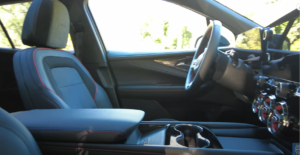
The Interior Sonata: A Symphony of Controversy
Journeying into the Blazer EV’s interior landscape is a divisive odyssey. Drawing parallels with the Camaro’s flamboyance, the RS and SS versions inundate the senses with a cacophony of cockpit-style layout, a wide center console, and resplendent round vents. The 11.0-inch configurable instrument cluster and the 17.7-inch infotainment touchscreen, though adorned with physical buttons, teeter on the brink of excess, craving a harmonious decluttering.
In the grand tapestry of automotive narratives, the 2024 Chevrolet Blazer EV emerges as a nuanced protagonist—a convergence of elegance, innovation, and a touch of controversy. Its journey into the automotive echelon, marked by technological prowess and aesthetic allure, beckons enthusiasts to explore the symphony that is the Blazer EV.
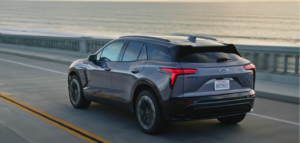
Performance
the 2024 Chevrolet Blazer EV doesn’t dance through serpentine canyon pathways within its 2LT or RS iterations. Nevertheless, it flaunts a responsive and refined electric propulsion system, anticipatable regenerative braking, commendable steering, and unparalleled ride quality, solidifying its stance in the upper echelons of its category. Within this domain, the Blazer EV garners extra commendation for its superior ride-handling dynamics, adding another accolade for its impeccably calibrated propulsion system and braking mechanisms.
The Blazer EV presents a diverse array of motor and drive-system configurations. The foundational LT (or 2LT) all-wheel-drive iterations integrate a permanent-magnet front motor in tandem with a rear induction motor, jointly producing 288 horsepower and 333 pound-feet of torque. Forthcoming front-wheel-drive renditions will omit the induction motor, with specific output metrics still pending. Across all LT models, a robust 85-kilowatt-hour battery pack is standard, affording an AWD range of 279 miles.
Advancing the hierarchy, the RS AWD variant mirrors the LT AWD setup. Meanwhile, the RS RWD variant discards the front motor but embraces the capacious 102-kilowatt-hour battery pack, coupled with a potent permanent magnet motor propelling the rear wheels, boasting 340 horsepower and 325 pound-feet of torque.
In prospect, the avant-garde Blazer EV SS progresses beyond its expansive battery pack, introducing an additional substantial permanent-magnet motor at the forefront, boasting a cumulative output of 557 horsepower and 648 pound-feet of torque. This augmentation is complemented by a sports suspension and enhanced front Brembo brakes.
The Blazer EV provides augmented regenerative capabilities through a steering-wheel paddle, coupled with a one-pedal driving mode featuring two intensity levels. Activating the Sport mode elevates both steering and brake responsiveness, yet the most conspicuous attribute is the auditory ambiance within the cabin, deftly channeled through the speakers.
Employing a multi-link rear suspension and a short-long-arm double-wishbone front suspension, inclusive of anti-roll bars at both axles, the Chevy Blazer EV maneuvers with a subdued, opulent heft reminiscent of luxury cars. It adeptly absorbs undulations on the road, and the elongated steering ratio imparts a sense of serenity and composure during highway navigation, albeit demanding more pronounced maneuvers in parking scenarios. In its all-wheel-drive configuration, the Blazer EV RS exhibits reluctance when pushed assertively through corners, while the rear-wheel-drive RS presents a handling equilibrium that beckons a more amiable approach.
Inquiries persist regarding the Blazer EV’s 4WD capabilities. Indeed, the Blazer EV is available in three distinct trims—LT, RS, and SS—each offering the option of a dual-motor all-wheel-drive configuration. It’s imperative to dispel any notions of the Blazer EV as an off-road marvel; despite a modicum of undercarriage fortification, its ground clearance is a modest 7.9 inches, and it lacks a designated off-road mode.
While the Blazer EV possesses a towing capacity, it teeters on the edge, limited to a mere 1,500 pounds.
Curiosity extends to the velocity of the Chevrolet Blazer EV. The Blazer EV AWD boasts a commendable acceleration, propelling to 60 mph in approximately six seconds. Impressively, the Blazer EV RS RWD, drawing from initial assessments, maintains a comparable pace.
For those inclined towards boasting privileges, the Blazer SS stands out; featuring the “Wide Open Watts” (WOW) mode and superior specifications, it achieves the 60 mph mark in under four seconds.
In scrutinizing the 2024 Chevrolet Blazer EV, accolades are accorded for its precision in construction and the capacious cargo area; nevertheless, a demerit is assigned for the somewhat lacking comfort of its seating, resulting in a cumulative rating of 6.
Comfort & Quality
Measuring approximately 192 inches in length and 78 inches in width, the Blazer EV transcends the dimensions of its counterparts like the Ford Mach-E or Hyundai Ioniq 5. In terms of both length and width, its proximity aligns more closely with the specifications of the Jeep Grand Cherokee or, intriguingly, the traditional petrol-powered Chevy Blazer.
This culminates in an extended, serene passenger compartment spanning two tiers, boasting expansive door apertures for facile ingress and egress. The apprehension of front and rear occupants grappling for legroom is alleviated, thanks to ample space. The interior encapsulates an intimate, hushed enclosure, where the sumptuous ride quality contributes significantly to an overall deluxe impression—albeit not entirely flawless.
seating arrangements, the anomaly manifests itself within the Blazer. The front and rear seats within this vehicular entity convey an unmistakable brevity, rendering them insufficient and lacking in support—especially noticeable in the front seats, which exhibit a dearth of bolstering within the corners. The spatial configuration of the front seats suggests a potential for a lower height adjustment, given the low-set orientation of surrounding dashboard cues and interface points. Similarly, the rear compartment presents a challenge to headroom, exacerbated by the inclusion of a glass roof.
While the Blazer EV astounds in its packaging, it seems, at a superficial glance, to underutilize the myriad nooks and crannies afforded by the skateboard platform. The rear seats, when folded forward, achieve a nearly level disposition, thereby expanding the already commodious 25.5 cubic feet behind the rear seatbacks to a capacious 59.1 cubic feet. The liftover height measures a modest 29.7 inches, accompanied by a generously proportioned liftgate opening. However, upon lifting the hood, the absence of a frunk becomes apparent. Notwithstanding, compensatory storage solutions reside within the door pockets, a tangible glovebox, and the posterior section of the central console.
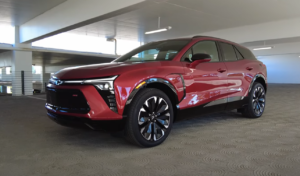
Safety
In evaluating the prowess of the Chevrolet Blazer EV in energy conservation, a distinctive inquiry arises: Does it perform admirably in the realm of energy efficiency?
In contrast to its counterparts within this automotive category, the Blazer EV transcends expectations by traversing greater distances with diminished energy consumption. This proves advantageous, as it translates to reduced intervals between essential charging pit stops. Intriguingly, the Environmental Protection Agency (EPA) is yet to bestow its official rating on the Blazer EV. Presently, General Motors (GM) has solely divulged the range and efficiency details for two of the lineup’s drive variations.
For the all-wheel-drive iterations of the LT and RS, outfitted with the more modest 85-kilowatt-hour battery pack, a commendable range of 279 miles is attainable. In contrast, the rear-wheel-drive incarnation of the RS, boasting the more capacious 102-kilowatt-hour battery pack, flaunts an even more remarkable range, clocking in at 324 miles.
This translates into a commendable efficiency statistic, surpassing the threshold of 3 miles per kilowatt-hour for both single- and dual-motor renditions of the Blazer. Such an accomplishment stands as an impressive feat, especially considering the dimensions of the vehicle, earning it a resounding 10 on the efficiency scale.
Conspicuously absent from official ratings are the foundational front-wheel-drive models of the LT, housing the smaller battery pack, and the high-performance SS variants, endowed with the more voluminous pack. Nonetheless, GM proffers an approximation, suggesting the Blazer SS will effortlessly traverse approximately 290 EPA-rated miles, a testament to its substantial energy endurance.
How fast does the Blazer EV charge?
The Blazer EV comes with two battery pack options: an 85-kwh pack and a larger 102-kwh pack. Fast-charging capabilities are impressive, with the 85-kwh pack reaching a peak of 150 kw and the 102-kwh pack hitting 190 kw. This translates to approximately 69 miles and 78 miles of range in just 10 minutes for the respective packs.
For Level 2 AC charging, the Blazer EV can handle up to 11 kW. Using a 240-volt, 60-amp home circuit and a 48-amp home charger, the vehicle can fully charge in less than eight hours for the smaller pack or less than 10 hours for the larger pack.
Starting in 2024, a GM Energy hardware set will be offered for the Blazer EV. This feature allows the vehicle to output up to 9.6 kW, enabling it to serve as a backup power source for the home. However, specific details about this capability have not been fully disclosed yet.
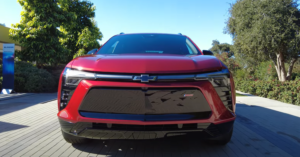
Conclusion
In conclusion, the 2024 Chevrolet Blazer EV represents a leap into the future of driving. From its eco-friendly design to the advanced technology, the Blazer EV offers a driving experience that is both exhilarating and sustainable. As electric vehicles become increasingly prevalent, Chevrolet’s commitment to innovation ensures that the Blazer EV remains at the forefront of this transformative industry.
FAQs About the 2024 Chevrolet Blazer EV
- Q: What is the driving range of the 2024 Chevrolet Blazer EV?
- A: The driving range of the Blazer EV varies, but on a full charge, it can cover an impressive distance, making it suitable for daily commutes and longer journeys.
- Q: Are there government incentives for purchasing the Blazer EV?
- A: Yes, there are government incentives and rebates available for the purchase of electric vehicles, including the 2024 Chevrolet Blazer EV.
- Q: How does the maintenance of the Blazer EV compare to traditional vehicles?
- A: The maintenance of the Blazer EV is generally simpler than traditional vehicles, with fewer moving parts and a focus on longevity.
- Q: What distinguishes the different trim levels of the Blazer EV?
- A: The trim levels offer various features and customization options, catering to different preferences. Higher trim levels may include advanced technology and premium amenities.
- Q: How can I test drive the 2024 Chevrolet Blazer EV?
- A: To experience the Blazer EV firsthand, visit your local Chevrolet dealership and inquire about test drive opportunities.